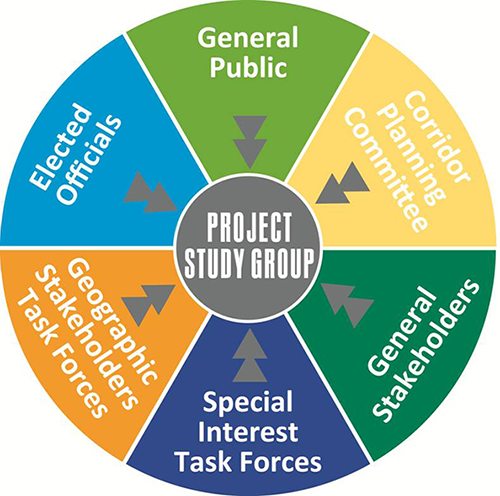


Context Sensitive Solutions (CSS) and Stakeholder Involvement Plan (SIP)
Context Sensitive Solutions (CSS)
This project will be conducted using principles of IDOT's guidelines for Context Sensitive Solutions (CSS) Process. The CSS approach will provide stakeholders with the tools and information they require to effectively participate in the study process including an understanding of the NEPA process, transportation planning guidelines, design guidelines, and the relationship between transportation issues and project alternatives. In other words, using the CSS process should provide all project stakeholders a mechanism to share comments or concerns about transportation objectives and project alternatives, as well as improve the ability of the project team to understand and address concerns raised. This integrated approach to problem solving and decision-making will help build a general understanding of the project among all interested community members and promote involvement through the study process.
Specifically, the CSS process will help:
- Understand the stakeholders' key issues and concerns.
- Involve stakeholders in the decision-making process early and often.
- Establish an understanding of the stakeholders' project role.
- Address all modes of transportation and land use issues.
- Apply flexibility in design to address the stakeholders' concerns whenever possible.
- Identify and engage the general public that lives, works, or visits facilities within the project area.
- Educate the public on the project goals and direction.
- Incorporate regional stakeholders in the discussion.
Stakeholder Involvement Plan (SIP)
Click here to access the Stakeholder Involvement Plan.
The goal of this SIP is to actively seek the participation of communities, agencies, individual interest groups, and the general public throughout the project development process. A robust stakeholder involvement process holds the keys to developing a strong understanding of the project, minimizing adverse impacts to the community, and fostering public support for the project. The SIP will be used as a blueprint for defining methods and tools to educate and engage all stakeholders in the decision making process for this project. The SIP has been developed to ensure that stakeholders are provided a number of opportunities to be informed, engaged, and provide input as the project progresses.
The SIP incorporates CSS project development principles from Section 19-2 of IDOT's Bureau of Design and Environment (BDE) Manual and CDOT's public involvement goals for this project. IDOT and CDOT are committed to supporting and implementing communication processes to gain information from stakeholders that will be used to develop an informed solution for the project. The success of the committee and public outreach structure outlined in this SIP relies on consistent and robust communications between all parties.
Learn more about the NDLSD Task Force in this Task Force Overview Handout

This is a fluid plan and may be continually updated during the life of the project. It will be routinely reviewed, evaluated and modified to reflect the changes and needs of the project and the public.
- Identify the Project Study Group (PSG)
- Identify the Corridor Planning Committee (CPC)
- Identify the Task Force participants.
- Identify general stakeholders.
- Identify the roles and responsibilities of the lead agencies.
- Identify responsibilities of other agencies.
- Establish the timing and type of involvement activities with all stakeholders.
- Establish stakeholder requirements for providing timely input into the project development process.